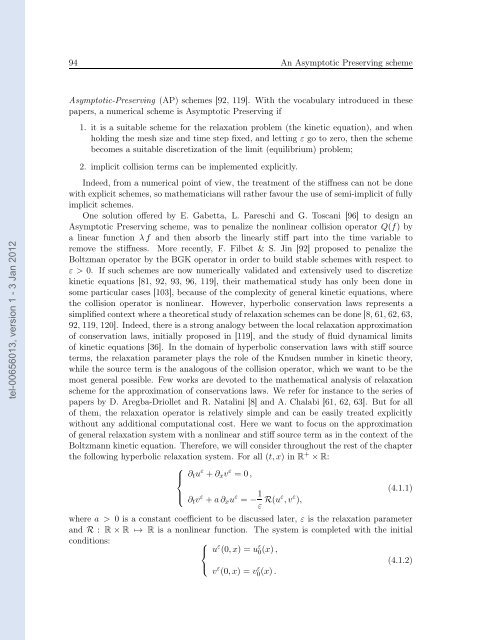Modélisation, analyse mathématique et simulations numériques de ...
Modélisation, analyse mathématique et simulations numériques de ...
Modélisation, analyse mathématique et simulations numériques de ...
Create successful ePaper yourself
Turn your PDF publications into a flip-book with our unique Google optimized e-Paper software.
tel-00656013, version 1 - 3 Jan 2012<br />
94 An Asymptotic Preserving scheme<br />
Asymptotic-Preserving (AP) schemes [92, 119]. With the vocabulary introduced in these<br />
papers, a numerical scheme is Asymptotic Preserving if<br />
1. it is a suitable scheme for the relaxation problem (the kin<strong>et</strong>ic equation), and when<br />
holding the mesh size and time step fixed, and l<strong>et</strong>ting ε go to zero, then the scheme<br />
becomes a suitable discr<strong>et</strong>ization of the limit (equilibrium) problem;<br />
2. implicit collision terms can be implemented explicitly.<br />
In<strong>de</strong>ed, from a numerical point of view, the treatment of the stiffness can not be done<br />
with explicit schemes, so mathematicians will rather favour the use of semi-implicit of fully<br />
implicit schemes.<br />
One solution offered by E. Gab<strong>et</strong>ta, L. Pareschi and G. Toscani [96] to <strong>de</strong>sign an<br />
Asymptotic Preserving scheme, was to penalize the nonlinear collision operator Q(f) by<br />
a linear function λf and then absorb the linearly stiff part into the time variable to<br />
remove the stiffness. More recently, F. Filb<strong>et</strong> & S. Jin [92] proposed to penalize the<br />
Boltzman operator by the BGK operator in or<strong>de</strong>r to build stable schemes with respect to<br />
ε > 0. If such schemes are now numerically validated and extensively used to discr<strong>et</strong>ize<br />
kin<strong>et</strong>ic equations [81, 92, 93, 96, 119], their mathematical study has only been done in<br />
some particular cases [103], because of the complexity of general kin<strong>et</strong>ic equations, where<br />
the collision operator is nonlinear. However, hyperbolic conservation laws represents a<br />
simplified context where a theor<strong>et</strong>ical study of relaxation schemes can be done [8, 61, 62, 63,<br />
92, 119, 120]. In<strong>de</strong>ed, there is a strong analogy b<strong>et</strong>ween the local relaxation approximation<br />
of conservation laws, initially proposed in [119], and the study of fluid dynamical limits<br />
of kin<strong>et</strong>ic equations [36]. In the domain of hyperbolic conservation laws with stiff source<br />
terms, the relaxation param<strong>et</strong>er plays the role of the Knudsen number in kin<strong>et</strong>ic theory,<br />
while the source term is the analogous of the collision operator, which we want to be the<br />
most general possible. Few works are <strong>de</strong>voted to the mathematical analysis of relaxation<br />
scheme for the approximation of conservations laws. We refer for instance to the series of<br />
papers by D. Aregba-Drioll<strong>et</strong> and R. Natalini [8] and A. Chalabi [61, 62, 63]. But for all<br />
of them, the relaxation operator is relatively simple and can be easily treated explicitly<br />
without any additional computational cost. Here we want to focus on the approximation<br />
of general relaxation system with a nonlinear and stiff source term as in the context of the<br />
Boltzmann kin<strong>et</strong>ic equation. Therefore, we will consi<strong>de</strong>r throughout the rest of the chapter<br />
the following hyperbolic relaxation system. For all (t,x) in R + ×R:<br />
⎧<br />
⎪⎨<br />
∂tu ε +∂xv ε = 0,<br />
⎪⎩<br />
∂tv ε +a∂xu ε = − 1<br />
ε R(uε ,v ε ),<br />
(4.1.1)<br />
where a > 0 is a constant coefficient to be discussed later, ε is the relaxation param<strong>et</strong>er<br />
and R : R × R ↦→ R is a nonlinear function. The system is compl<strong>et</strong>ed with the initial<br />
conditions: ⎧<br />
⎨ u<br />
⎩<br />
ε (0,x) = u ε 0 (x),<br />
(4.1.2)<br />
v ε (0,x) = v ε 0 (x).

















